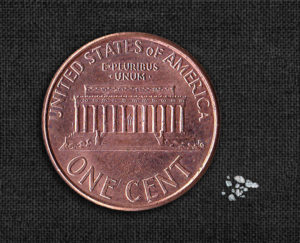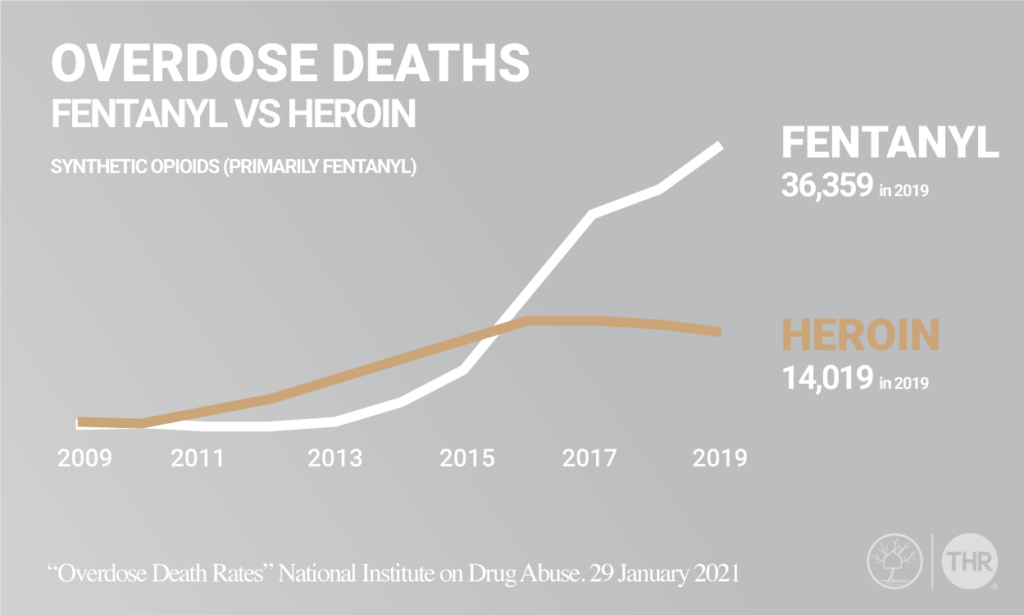Quitting Fentanyl: Understanding One of the Most Dangerous Opioids
What is Fentanyl?
Fentanyl is a substance that can be life-threatening. The synthetic opioid originally developed to treat severe pain, especially after surgery or in chronic cases. Fentanyl is one of the potent opioids available and is 100 times stronger than morphine.1
This prescription drug is highly addictive and can even be deadly. It is currently legal to produce in the U.S. for medical use. However, it is also produced and sold illegally as a recreational drug because of its heroin-like effects and strength. Because it is so much stronger than heroin, it has been a major cause of the increase in opioid overdose deaths in the U.S. There is a clear need for fentanyl addiction treatment in North Carolina and beyond. If you’re looking for substance abuse treatment, call Tree House Recovery at 910-812-1728 today
Fentanyl is a Schedule II narcotic [1].
This means it is currently considered to have an acceptable medical use, has a high abuse potential, and using it can lead to severe mental or physical dependence.
Narcotic Analgesic [2].
TL;DR: Tree House Recovery NC offers one of the top fentanyl rehab programs in North Carolina. Our highly-rated addiction treatment program offers medical detox, personalized therapy, and ongoing support. What makes our program unique is its ability to treat the root of fentanyl addiction —not just the symptoms.
Fentanyl Quiz:
If you suspect you or someone might be addicted to fentanyl, try our free quiz.
Where Does Fentanyl Come From?
Fentanyl was created by Dr. Paul Janssen in 1959 and patented by his company Janssen Pharmaceuticals. As a potent narcotic analgesic (pain reliever), it has been widely used in medical settings to manage chronic and extreme pain post-surgery. In addition, it is often used to reduce pain for cancer patients. Unfortunately, it also creates euphoric and mood-elevating effects like other opioids and is often abused.
As one of the most addictive substances, fentanyl is widely sold illegally. So, where does all this street fentanyl come from? Most of today’s street fentanyl is illegally synthesized in labs throughout the world. However, legally produced fentanyl is also a common source.2
Fentanyl Video
Tree House addiction counselor Rob Mo explains the signs and symptoms of fentanyl use, withdrawal symptoms, how it is used, and what to expect in fentanyl addiction treatment.
What Does Fentanyl Look Like?
In its raw powder form, it is shades of off-white to light brown. But, fentanyl is a hard drug to spot because it is typically cut into other street drugs to add to their potency. If it has been added to white drugs like meth or cocaine, you may see some brown spots.
Fentanyl has been increasingly added to counterfeit prescription benzo and opioid drugs like Xanax and oxycodone as well as street drugs like ecstasy to add to their euphoric effects. Again, this can be hard to spot, but you may find discoloration or flaws in the identifying marks on the drugs. The best way to know if a drug has been cut with fentanyl is to use a fentanyl test strip.

Fentanyl Potency
Fentanyl is one of the most potent opioids. It is 50 times stronger than heroin1 and up to 100 times stronger than morphine.2
How Is Fentanyl Used?
If prescribed by a doctor, there are three ways fentanyl can be taken. It can be injected directly into the blood, absorbed into the skin through a patch, or absorbed orally in a lozenge form. Legally and illegally manufactured fentanyl are both abused. When used and abused for recreation, it is taken in several ways. The illegally made fentanyl is typically made as a powder, blotted on paper, put in eye droppers or nasal sprays, or pressed into pills.3
However, It is primarily cut into other drugs like heroin, meth, or cocaine, and it can also be pressed into MDMA pills. Making fentanyl is cheap, and adding it to other drugs reduces their cost. Unfortunately, the added fentanyl increases the risk of overdose when people take drugs unknowingly mixed with fentanyl. Our fentanyl rehab center in North Carolina can make a difference for those who are ready to break free of fentanyl addiction and reduce the risk of an overdose.
Dangers of Fentanyl:
Fentanyl’s potency is a big reason it is so dangerous. It is at the top of the list of most potent opioids. It is 50 times stronger than heroin and up to 100 times stronger than morphine.1 Fentanyl abuse has a high overdose death rate because it is so addictive, potent and often cut into other drugs without people knowing.
Fentanyl Overdose Rates:
Currently, opioids—73% of which are synthetic—are the leading cause of overdose deaths in the United States. In 2019, overdose deaths increased by 4% compared to 2018—there were 70,630 drug overdose deaths in the U.S. Opioids were involved in 71% of 2019’s overdose death count in 2019, or 49,860 deaths.4
For more information on Fentanyl and Heroin
Fentanyl vs Heroin Overdose:

Signs of Fentanyl Abuse
Physical Signs:
Like other opioids, some physical signs of fentanyl abuse are small “pinned” pupils and unexpected drowsiness. Opioid drowsiness, aka “nodding out,” is easy to spot. For example, you might find someone falling or nodding off mid-sentence. A drop in weight and opioid withdrawal symptoms and side effects are also signs of use.
Changes in Behavior
Opioids cause a high level of euphoria for most people who abuse them. So you might see random shifts of extreme happiness. Some other behaviors to look out for are a loss of energy, little appetite, mood swings, and memory problems. If your loved one is exhibiting these behaviors and you suspect opioid abuse, it’s time to take action through a fentanyl addiction treatment center.
Side Effects of Fentanyl
You can also look for some of the side effects of fentanyl use if you think someone may be abusing the drug. These include:
- Confusion
- Constipation
- Drowsiness
- Dizziness
- Euphoria
- Nausea
- Pain relief
- Sedation
- Tolerance
- Relaxation
- Respiratory depression and arrest
- Unconsciousness
- Urinary retention
Common Names for Fentanyl
Like most commonly abused drugs, fentanyl goes by many different names on the street. Depending on where you are in the U.S., the nicknames may vary. Below is a list of some of the most common street names. If you hear someone using these names, it can signal that someone is consuming fentanyl.
Fentanyl Street Names
- Apace
- China Girl
- China Town
- China White
- Dance Fever
- Fetti
- Goodfella
- Great Bear
- He-Man
- Murder 8
- Poison
- Tango & Cash
- TNT
Fentanyl Brand Names
- Actiq® “lollipops” oral transmucosal lozenges
- Sublimaze® Injection
- Fentora™ effervescent buccal tablets
- Abstral® sublingual tablet
- Subsys™ sublingual spray
- Lazanda® nasal spray
- Duragesic® transdermal fentanyl patch
Fentanyl Withdrawal Symptoms
One reason fentanyl is so addictive is that withdrawal symptoms start a few hours after it is taken. Withdrawal symptoms are painful for those who are dependent on this substance. These symptoms include1:
- Cold flashes
- Diarrhea
- Intense cravings
- Leg spasms
- Muscle and bone pain
- Sleep problems
- Vomiting
Our Fentanyl Addiction Treatment Program in North Carolina
There are three phases required to treat fentanyl addiction successfully. Phase one is medical detox. Phase two focuses on drug addiction treatment. Lastly, phase three provides aftercare with a customized plan for long-term recovery.
Fentanyl Medical Detox: Phase 1
 It’s important to understand that the medical detox environment is the safest and most effective place to start the recovery process. Fentanyl, like other opioids, comes with a very uncomfortable physical detox. As a result, the likelihood of relapse without medical detox support dramatically increases. Another vital thing to know is that detox is about physical stabilization. It will help you deal with physical dependence, not the root cause of the addiction. Therefore it is critical that a quality addiction treatment program immediately follows detox.
It’s important to understand that the medical detox environment is the safest and most effective place to start the recovery process. Fentanyl, like other opioids, comes with a very uncomfortable physical detox. As a result, the likelihood of relapse without medical detox support dramatically increases. Another vital thing to know is that detox is about physical stabilization. It will help you deal with physical dependence, not the root cause of the addiction. Therefore it is critical that a quality addiction treatment program immediately follows detox.
Fentanyl Addiction Treatment: Phase 2
 After detox and physical stabilization, in this phase of fentanyl recovery treatment focuses on the root of your addiction. Our fentanyl addiction treatment center in North Carolina offers an integrative and evidence-based approach to addiction treatment. SUDs impact three areas of health, and they all need to be brought back to an optimized level. These include:
After detox and physical stabilization, in this phase of fentanyl recovery treatment focuses on the root of your addiction. Our fentanyl addiction treatment center in North Carolina offers an integrative and evidence-based approach to addiction treatment. SUDs impact three areas of health, and they all need to be brought back to an optimized level. These include:
- Biological health – The most effective rehabs have a fitness component.
- Mental health – Trauma, internal conflict, and self-understanding are vital.
- Social health – Repairing and learning to build strong, healthy relationships is critical for sustained happiness and lasting sobriety.
Aftercare For Fentanyl Addiction: Phase 3
 Armed with a sustainable maintenance plan from your time in our fentanyl addiction treatment program, good aftercare support will reinforce a strong foundation for recovery. Effective aftercare plans and programs include a focus on physical, mental, and social health.
Armed with a sustainable maintenance plan from your time in our fentanyl addiction treatment program, good aftercare support will reinforce a strong foundation for recovery. Effective aftercare plans and programs include a focus on physical, mental, and social health.
Through aftercare, you’ll be able to:
- Maintain peer connections
- Create and sustain a physically healthy regimen
- Maintain a personal growth plan
Fentanyl Rehab in Wilmington:
Detoxing from fentanyl can be tough, the best way to go about detoxing from fentanyl is through a medically assisted detox program. Medically assisted detox can dramatically reduce the pain and uncomfortability of withdrawals through medications, as well as minimizing the chance of relapse during the peak stages of symptoms.
If you or a loved one needs help finding a medically assisted detox, give our admissions team a call.
Fentanyl Detox
Starting your recovery journey begins with detoxification. Detox aims to help men and women start their recovery journey by supporting them through the fentanyl withdrawal process, which can be deadly.
Detoxing will look different for each person, but it will typically invovled a medical staff that helps the patient through the physical symptoms of addiction. The next level of care may include some treatment for withdrawals to certain substances, like opioids, as the patient begins addiction treatment.
Our admissions team can help you or someone you know find a medically assisted detox near you today.
Inpatient Fentanyl Addiction Treatment
For some people struggling with substance use disorders, inpatient programs are the best treatment for fentanyl addiction. Because addiction recovery takes time, effort, and skill building, inpatient programs are ideal for people trying to end their addiction and find tools and methods to prevent relapsing.
Outpatient Fentanyl Rehab
Outpatient rehab programs are ideal for people who must continue going to work or school or are ready to continue living their lives while developing the tools and skills needed to continue a sober lifestyle.
Fentanyl PHP
Partial hospitalization program (PHP) for fentanyl addiction allows clients to return home after a structured day of working on their mental, social, and physical health, giving clients the time to put their newly developed skills into practice.
Our addiction treatment program, led by skilled staff members who want to help clients develop the social, mental, and physical strength to curb cravings and maintain a healthy, happier lifestyle, takes a holistic approach that focuses on you and your recovery.
The inpatient fentanyl addiction treatment includes:
- Meditation therapy
- Cognitive behavioral therapy (CBT)
- Individual therapy
- Group therapy
- Fitness therapy
Each of these treatments is evidence-based and led by a skilled staff that wants to help clients graduate and see the positive and empowering changes in their lives.
Fentanyl IOP
Similar to PHP, a fentanyl intensive outpatient programs (IOPs) are designed to work with patients’ lifestyles as they go through addiction treatment. These evening classes, which take place over 90 days, help people develop skills through evidence-based treatment with a holistic approach.
Some of the life skills clients develop in our IOP include:
- Self-discipline
- Self-awareness
- Self-motivation
- Conflict resolution
- Relationship skills
- Self-care
- Healthy lifestyle skills
Fentanyl OP
Tree House Recovery specializes in PHPs and IOPs that work for people who want holistic treatment while addressing their mental health concerns. But there is another type of fentanyl rehab: standard outpatient programs (OPs).
Fentanyl OPs are less frequent than IOPs but can include many of the same features of an IOP.
Aftercare for Fentanyl Addiction
Graduating from a fentanyl rehab program is a significant recovery milestone. However, some may need additional support after rehab to ensure the skills and tools developed at Tree House Recovery stay sharp.
Tree House Recovery offers additional aftercare for clients taking part in the fentanyl addiction treatment program to help clients continue living a substance-free life. Because sobriety looks different for everyone, our rehab aftercare is flexible and works with clients to maintain the life they worked so hard for.
Aftercare options for fentanyl addiction depend on the person’s circumstances but may include the following:
- In-person check-ins
- Remote check-ins over the phone or video call
- Smartphone apps designed to promote sobriety
- Re-enrolling in a formal rehab program
- Attending a mutual self-help group
- Enrolling in an alum recovery program
Addiction aftercare programs available through Tree House Recovery offer many benefits, including promoting and preserving the hard work you have done to reach this recovery milestone.
How to Find the Best Treatment for Fentanyl Addiction in North Carolina
Tree House Recovery NC is here to help you or your loved ones find the best treatment for fentanyl addiction when they are ready to start the recovery journey. Every person’s experience with fentanyl and addiction is different, so there will be various resources and treatments that may work better for one person and not for another.
It is essential when researching fentanyl addiction treatments to look at what the treatments will look like, the length of treatment, and how the success rates are measured and clearly communicated.
Local Resources
With fentanyl and other synthetic opioids being the cause of 70% of fatal overdoses in 2022, seeking help for a fentanyl addiction can be a lifesaving choice.
There is a list of resources available to you or your loved one to find immediate help. You can also call Tree House Recovery NC to find local help for fentanyl addiction recovery resources near you.
How Our Fentanyl Rehab Can Help
Our admission team understands that recovery looks different for each individual struggling with addiction, which is why we are here to help you find the best treatment that aligns with your needs.
While Tree House Recovery NC will soon offer a detox program for substance use disorders, our treatment center currently provides holistic, evidence-based rehabs and IOP, as well as an alumni and aftercare program, to help people gain the knowledge, skills, and support they need to maintain sobriety and enjoy living life again.
Tree House Recovery also offers PHPs at our treatment centers in Portland, OR, Orange County, CA, and Nashville, TN.
We also offer a family program for those with loved ones struggling with addiction. Our program’s goal is to help you create the boundaries that will help your loved one without unknowingly enabling their addiction and how to create a strong support system for them once they are in or graduated from an addiction treatment program.
Tree Recovery Fentanyl Addiction Treatment Center in NC
Addiction is powerful and can be difficult to fight, but no one should go through the recovery journey alone. Tree House Recovery’s programs in North Carolina are ready to help anyone experiencing substance use disorder or fentanyl addiction with the help they need to start living life again.
If you or your loved one is ready to find help for fentanyl addiction, contact Tree House Recovery NC at (910) 812-1728 or online.
FAQs About Fentanyl Addiction Treatment
What makes fentanyl more dangerous than other opioids?
Fentanyl is significantly more potent than heroin or morphine, and even tiny amounts can lead to overdose. It acts quickly and is often mixed with other substances, which increases the risk of a fatal reaction.
What are the signs of fentanyl addiction?
Signs of fentanyl addiction may include strong cravings, mood swings, excessive drowsiness, slowed breathing, and withdrawal symptoms. Many individuals also engage in risky behavior to find or use the drug.
How does Tree House Recovery NC treat fentanyl addiction?
Tree House Recovery NC uses a comprehensive, three-phase approach that includes medical detox, individualized therapy, and structured aftercare. The program is designed to treat the root causes of fentanyl addiction—not just the physical symptoms.
What support is available after completing the program?
After completing the program, clients receive a detailed aftercare plan that includes relapse prevention strategies, alumni support, and continued therapy options. Long-term success is built into the foundation of our care.

Author
Robert Funk: Addiction Writer

Author
Derek Swain: Addiction Writer
Sources
- NIDA. Fentanyl. Drugabuse.gov. Published February 2019. https://www.drugabuse.gov/publications/drugfacts/fentanyl
- DEA. Drug Scheduling. www.dea.gov. https://www.dea.gov/drug-information/drug-scheduling
- Davis K. Everything you need to know about fentanyl. Medicalnewstoday.com. Published January 22, 2019. Accessed June 20, 2025. https://www.medicalnewstoday.com/articles/308156#side-effects
- Mann B. More than a million Americans have died from overdoses during the opioid epidemic. NPR. https://www.npr.org/2021/12/30/1069062738/more-than-a-million-americans-have-died-from-overdoses-during-the-opioid-epidemi. Published December 30, 2021.
